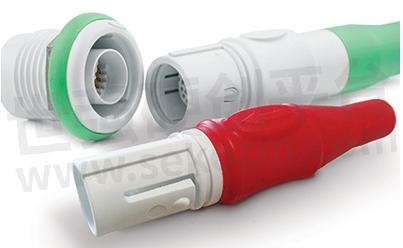How to Select the Right Electrical Connector for Specific Medical Devices and Applications

To ensure patient and provider safety, medical connectors must satisfy a variety of government and industry standards depending on the usage and specific applications.
Electrical connectors are used in a variety of medical devices and applications ranging from very large and expensive machines, such as magnetic resonance imaging (MRI) systems to lower-cost portable field devices such as defibrillators. Depending on the specific application, these connectors are engineered to satisfy different requirements for reliability and a number of uses. This affects their design, manufacturing techniques, testing, and materials, thus affecting the life cycle costs. It is imperative to understand the requirements for electrical medical connectors and how the design and cost of these connectors are affected by these requirements. Smiths Interconnect is a global provider of cutting-edge connectivity solutions, and the HyperGrip® series of high-reliability medical connectors solve countless device requirements without compromising on industry needs.
Connectivity requirements
Medical connectors must be capable of transmitting power, signal, or data from one cable to another in a safe, stable, and hygienic manner. They must also be designed in a fool-proof manner to provide reliable connections and prevent unintended or erroneous connections. To ensure patient and provider safety, medical connectors must satisfy a variety of government and industry standards depending on the usage and specific applications:
The International Electrotechnical Commission (IEC) has developed general requirements for basic safety and performance for a wide range of medical electrical equipment and systems (IEC 60601-1), which is widely accepted in many countries throughout the world.
In the U.S., medical device manufacturers must demonstrate compliance with several requirements in the Premarket Approval (PMA).
The Ingress Protection rating (IP) is an international standard for rating how well an electrical connector can prevent the ingress of dirt and water from reaching the contacts, which could present a potential hazard to patients and medical equipment.
UL94 tests determine the flammability of plastic materials based on burning speed, burning time, and dripping behavior, and the ability of the plastic material to extinguish the flame after it is ignited.
These and other standards provide guidelines for medical devices that affect numerous design characteristics, among those including material selection, the maximum number of sterilization cycles, the maximum number of mating cycles, minimum and maximum operating temperatures, EMI shielding, and finger-proofing. Conformance to these standards drives medical connector quality, performance, and cost. For purposes of affordability, it is desirable to match the connector capabilities to the expected lifetime, cost, and reliability of the medical equipment. For example, it may not be desirable to use a low-cost medical connector that is qualified for a limited number of sterilization cycles on high-cost medical equipment designed for numerous sterilization cycles, and vice versa. Medical device designers must therefore be cognizant of the medical device applications in which the connectors will be used, as well as the design, reliability, and cost of the connectors themselves.
HyperGrip® Connectors
The Smiths Interconnect HyperGrip® connectors were designed specifically for the medical industry and conform to the relevant standards and guidelines for the specific application HyperGrip® is a circular plastic, user-configurable, color-coded connector with push/pull latching design allowing for the one-hand disconnect as shown in Figure 1. It is offered in several multi-pin configurations with a spring probe, fiber optic (expanded beam and butt joint), and coaxial contacts that can be shielded for EMI/RFI protection.

One of the unique features of HyperGrip® connectors is that they are available in Standard, Flex, and Disposable versions. The Standard connectors offer high reliability supporting over 20,000 mating cycles, whereas the Flex connector provides the highest level of reliability and a premium life cycle of up to 2,000 sterilization cycles. The Disposable version provides a low cost of ownership for single- or limited-use and is designed to support over-molding and high-volume production methods. The Disposable HyperGrip is also capable of withstanding at least 30 cycles while ensuring the connector performance in terms of insulation resistance, dielectric withstanding voltage, current carrying, and low-level current resistance.
The HyperGrip® connectors are customer keyable for quick and accurate connections on medical equipment. This unique HyperGrip® keying system allows customers greater freedom and flexibility to build connectors with six different keying options and five different color codes using a set of common components, thereby ensuring error-free connections and effortless mating recognition while reducing lead time and inventory. Furthermore, the Standard, Flex, and Disposable connectors can be mixed and matched to provide the optimum life cycle and lowest usage cost for medical equipment applications. For example, a standard and a disposable HyperGrip® connector can be used for a patient monitoring application, where the standard receptacle improves the field life of the monitoring system, while the disposable plug supports a low cost per therapy for the sensor without compromising electrical performance.
- +1 Like
- Add to Favorites
Recommend
- Smiths Interconnect announced Hypergrip® Connector Series for the Medical Market Segment
- Smiths Interconnect Completes Product Offering for Disposable Healthcare Devices
- Smiths Interconnect Expands Its Product Offering for Medical Applications
- Smiths Interconnect New Hypertac Green Connect Contact Technology is Designed to Reduce Power Loss
- Smiths Interconnect Hypertac Green Connect: A Game-changer in the Battery Electric Vehicles Industry
- Smiths Interconnect Offered Isolators to Support NASA’s Europa Clipper Mission to Explore Jupiter’s Moon
- How Smiths Interconnect Keeps The Medical World Connected
- Smiths Interconnect’s DaVinci 112 High-Speed Test Socket Wins Best Test Measurement Award at the 2024 Global Electronics Achievement Awards
This document is provided by Sekorm Platform for VIP exclusive service. The copyright is owned by Sekorm. Without authorization, any medias, websites or individual are not allowed to reprint. When authorizing the reprint, the link of www.sekorm.com must be indicated.






























































































































































































































































































































































































































































































































































































































































































































































































































































































